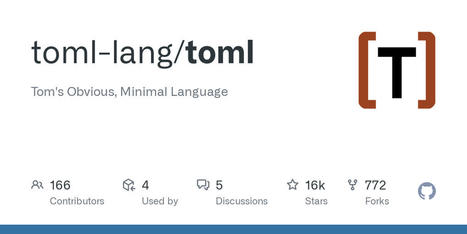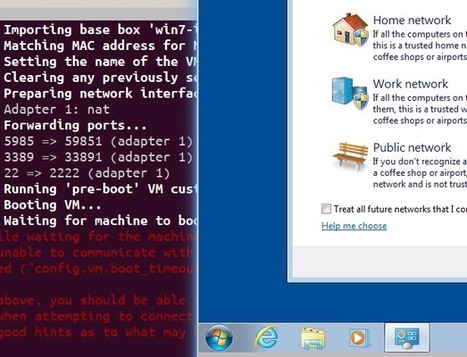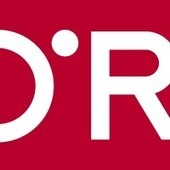 Your new post is loading...
 Your new post is loading...

|
Scooped by
Mickael Ruau
November 21, 2021 9:07 AM
|
Tom's Obvious, Minimal Language. Contribute to toml-lang/toml development by creating an account on GitHub.

|
Scooped by
Mickael Ruau
June 11, 2020 4:33 AM
|
Covers 16 patterns that serve to increase team agility, enhanced by general guidelines for improved SCM, and a list of resources.

|
Scooped by
Mickael Ruau
February 2, 2017 5:01 AM
|
Dans cet environnement hétérogène, nous utilisions déjà Vagrant pour gérer plusieurs VM Linux : intégration continue, bases de données, conteneur Web. Vagrant

|
Scooped by
Mickael Ruau
November 24, 2014 4:50 AM
|
Suite aux deux excellents articles de Michael Pagès sur Docker (Docker présentation – Part1, et Docker – Tutoriel : Isolation d’application par Projet – Part 2), j’ai eu envie d’essayer d’utiliser cet outil. Cependant, j’ai rencontré quelques difficultés lors de la mise en oeuvre, avec des résultats pas toujours voulus, ou bien de longues minutes à essayer de comprendre comment faire telle ou telle chose. Cet article n’est donc pas destiné à vous expliquer comment fonctionne docker, mais plutôt : “Comment l’utiliser”.

|
Scooped by
Mickael Ruau
June 25, 2014 2:43 AM
|
Open Source Software Configuration Management Tools: Source Control, Build, Deployment, Continuous Integration, Continuous Delivery

|
Scooped by
Mickael Ruau
January 7, 2014 8:40 AM
|
Pour maintenir en toute sérénité ses milliers de serveurs, Facebook a choisi le gestionnaire de configuration Open Source Chef pour gérer l'énorme infrastructure sur laquelle repose le géant des réseaux sociaux, en l'adaptant très légèrement.

|
Scooped by
Mickael Ruau
October 26, 2013 8:24 AM
|
the practice and the history of Continuous Integration and CruiseControl

|
Scooped by
Mickael Ruau
October 26, 2013 7:52 AM
|
L’intégration continue permet de révéler les éventuelles erreurs et incompatibilités des différentes parties réalisées par chaque développeur de l’équipe. Cruise Control, étant un serveur d’intégration continue, permet d’automatiser cette phase...

|
Scooped by
Mickael Ruau
October 26, 2013 7:31 AM
|
A comparison of Opscode's Chef and Puppet Lab's Puppet for Enterprise applications.

|
Scooped by
Mickael Ruau
October 19, 2013 7:45 AM
|
Have you gotten frustrated with Puppet? Corey Quinn offers an impassioned argument for his favorite open source alternative.

|
Scooped by
Mickael Ruau
October 17, 2013 4:46 AM
|
Ce sont les outils classiques de l'analyste-développeur. Ils simplifient les tâches redondantes et systématiques et lui permettent de se concentrer sur les points importants de la réalisation du logiciel.

|
Scooped by
Mickael Ruau
October 8, 2013 5:33 AM
|
Besides dependency management, with a little creativity Composer can also be used as a basic build automation tool for your PHP projects.

|
Scooped by
Mickael Ruau
October 8, 2013 5:29 AM
|
Packagist is the main Composer repository. It aggregates all sorts of PHP packages that are installable with Composer.
Browse packages or submit your own.
|

|
Scooped by
Mickael Ruau
October 26, 2021 8:19 AM
|
Si les CMDB sont encore appréciées, elles ne dominent plus la gestion IT. Découvrez les options d’intégration de la CMDB qui subsistent et pourquoi les administrateurs doivent envisager d’autres solutions que ces logiciels.

|
Scooped by
Mickael Ruau
September 24, 2019 3:41 AM
|
Most articles on the web tell you to use dotenv to manage environment variables. Now, it has over 6 million weekly downloads. It is not a bad library but it can be confusing, especially for beginners.

|
Scooped by
Mickael Ruau
April 27, 2016 1:05 AM
|
Learn to leverage the tools that will enhance your existing Configuration Management solution.

|
Scooped by
Mickael Ruau
August 27, 2014 11:47 AM
|
Ansible est une plate-forme logicielle libre pour la configuration et la gestion des ordinateurs. Elle combine le déploiement de logiciels multi-nœuds, l'exécution des tâches ad-hoc, et la gestion de configuration. Elle gère les différents nœuds par dessus SSH et ne nécessite l'installation d'aucun logiciel supplémentaire à distance sur eux.

|
Scooped by
Mickael Ruau
January 9, 2014 8:44 AM
|
In this article I aim to introduce Gulp, as it's fairly new, having been released around 6 months ago. Then, I'll compare it with Grunt, pointing out which tool does what better, and why.

|
Scooped by
Mickael Ruau
November 12, 2013 8:59 AM
|
ITIL V2 : La gestion des configurations

|
Scooped by
Mickael Ruau
October 26, 2013 8:23 AM
|
>>Automation of build and release >>Continuous Integration using ANT and Cruise Control >>Features of Cruise Control Using Cruise Control to achieve automatio

|
Scooped by
Mickael Ruau
October 26, 2013 7:42 AM
|
AnsibleWorks is the company behind Ansible, the radically simple IT orchestration solution that simplifies the way IT departments manage systems, applications, and cloud infrastructure.

|
Scooped by
Mickael Ruau
October 19, 2013 7:46 AM
|
Salt is a new approach to infrastructure management. Easy enough to get running in minutes, scalable enough to manage tens of thousands of servers, and fast enough to communicate with them in seconds. Salt delivers a dynamic communication bus for infrastructures that can be used for orchestration, remote execution, configuration management and much more.

|
Scooped by
Mickael Ruau
October 18, 2013 5:32 PM
|
PHP-CMDB is a webbased Configuration Management Database (CMDB). Based on your own model you can describe configuration items and relations between. Using the ...

|
Scooped by
Mickael Ruau
October 8, 2013 5:36 AM
|
Découvrez comment installer et utiliser Composer PHP pour inclure des bibliothèques PHP automatiquement.

|
Scooped by
Mickael Ruau
October 8, 2013 5:33 AM
|
Learn what information is needed in your composer.json file and how to list your library on Packagist so others can easily find it.
|
 Your new post is loading...
Your new post is loading...
 Your new post is loading...
Your new post is loading...

























TOML shares traits with other file formats used for application configuration and data serialization, such as YAML and JSON. TOML and JSON both are simple and use ubiquitous data types, making them easy to code for or parse with machines. TOML and YAML both emphasize human readability features, like comments that make it easier to understand the purpose of a given line. TOML differs in combining these, allowing comments (unlike JSON) but preserving simplicity (unlike YAML).
Because TOML is explicitly intended as a configuration file format, parsing it is easy, but it is not intended for serializing arbitrary data structures. TOML always has a hash table at the top level of the file, which can easily have data nested inside its keys, but it doesn't permit top-level arrays or floats, so it cannot directly serialize some data. There is also no standard identifying the start or end of a TOML file, which can complicate sending it through a stream. These details must be negotiated on the application layer.
INI files are frequently compared to TOML for their similarities in syntax and use as configuration files. However, there is no standardized format for INI and they do not gracefully handle more than one or two levels of nesting.
Further reading:
Get Involved
Documentation, bug reports, pull requests, and all other contributions are welcome!
Wiki
We have an Official TOML Wiki that catalogs the following: